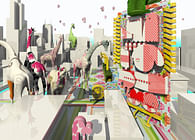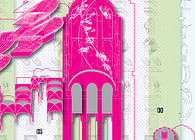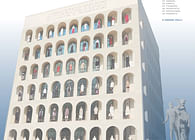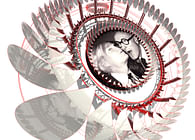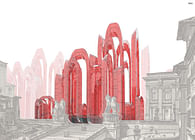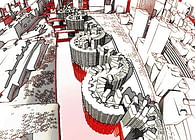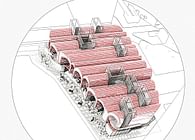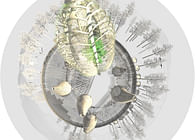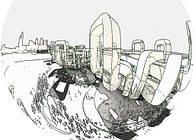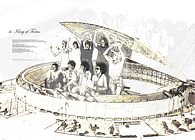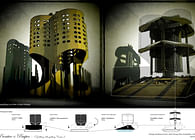
Bipolar City
ACT I :
In the city there was a building with bipolar disorder. This building was really many buildings, with many sizes and shapes. The appearance of this building and its many personalities were an unpredictable amalgamation of momentary thoughts on architecture.
The citizens of the city did not understand the bipolar building, and therefore avoided it. The story the citizens told about the bipolar building was ever changing and adapting to each generation.
This story was one in which the architect was unknown according to some, and to others the architect must have been a woman. The identity or gender of the architect was irrelevant, but their creation had become a living entity in the city. An entity with radical scalar elements, that of which critics were baffled. How could one structure appear as tiny as a doorway and simultaneously as a fortress of skyscrapers?
For years the city proposed to demolish the bipolar building. Each time the plans were approved the bipolar building would go dormant like a forest in winter and disappear. The seasons and cycles of the bipolar building revealed all the positive and negative aspects of her disorder. She, as she was called, displayed herself as a queen of the martyrs of the city. Her appearance was stunning, but yet not beautiful. She was slender and massive. She was a city unto herself. The bipolar building was the queen of the martyrs because her sacrifice made was one without style, that is an architectural style. The queen and her bipolar disorder was the equivalent of an architectural actor. She had the ability to become any character in the history of architecture. Her structure could not be categorized, yet she was a magician with the forces of gravity. She always sacrificed style in exchange for social impact. The bipolar building’s impact was also glorious in its delicate approach to foundations. Traditional buildings begin by establishing a strong and united foundation; one which can support both dead and live loads. The bipolar building only supported live loads and the queen was constantly in motion.
ACT II :
There is no linear nature to the development of this story or this bipolar building. She is a wild beast that cannot be tamed by the city she created or by its citizens. This being said, she is still the city’s queen. This queen does not have a single throne, but has thrones throughout the city. She would appropriate sites as her manic state grew more intense. These episodes were like a storm in the city; one on the horizon, being seen from a long distance off. The prairie town, which had become a city was her bipolar tempest made manifest. The physical artifacts of this bipolar city were in constant flux and her episodes multiplied exponentially. In her manic state, architecture was her weapon and she could not control her mental aspirations. The exaggerated building of her youth had matured into a monstrous city. This was in her mind the greatest of triumphs and the lowest of despairs. These conflicting emotions pulling in opposite directions were still creating an unpredictable and untamed architecture. How was this possible, triumph and despair combining into an unwilling creation made physical. This state of mania needed to pass, or the queen and her city would destroy itself. This condition did not pass, and the city with now hundreds of bipolar buildings was completely passive. What was once so alive and mobile, a truly living entity, had its melancholy destroy itself. The queen was dead. Her majesty, her kingdom, her mind had all betrayed what once was historic. Her mania left unchecked internalized into an unrecognizable self; a self without an architectural direction and a city without its queen.
ACT III :
A close confidante of the queen was a subject by the name of Viollet le Duc. He recited the following at the queen’s funeral. “To restore a building is not to repair it, nor to do maintenance, nor to rebuild, it is to re-establish it in an ultimate state that has never existed before.”
The city had fallen into disrepair, but Viollet le Duc’s words inspired the citizens. To restore the city, not repair it, the queen and her bipolar self would need to be reborn. Her rebirth would take place in a new form, one that mirrored itself upon the past. This mirroring allowed the queen’s persona to live again as a medicated procedure applied to an architectural agenda. In a medicated state the queen’s structure was strengthened to new heights. Her buildings restored, the citizens finally understood her genius. A genius whose condition was once considered an illness, had now remarkably transformed the public realm. The queen and her legacy were not dead, they had returned and built a new city. This bipolar city is still unpredictable as it always will be.
In the bipolar city a building with a disorder had become its queen again. Her condition grew into a city of unprecedented density, all of which was accessible via a single doorway into anyone’s mind.
Status: Competition Entry
Location: Chicago, IL, US
My Role: design scientist & writer
Additional Credits: S. Hjelte Fumanelli - project architect & digital modeling

